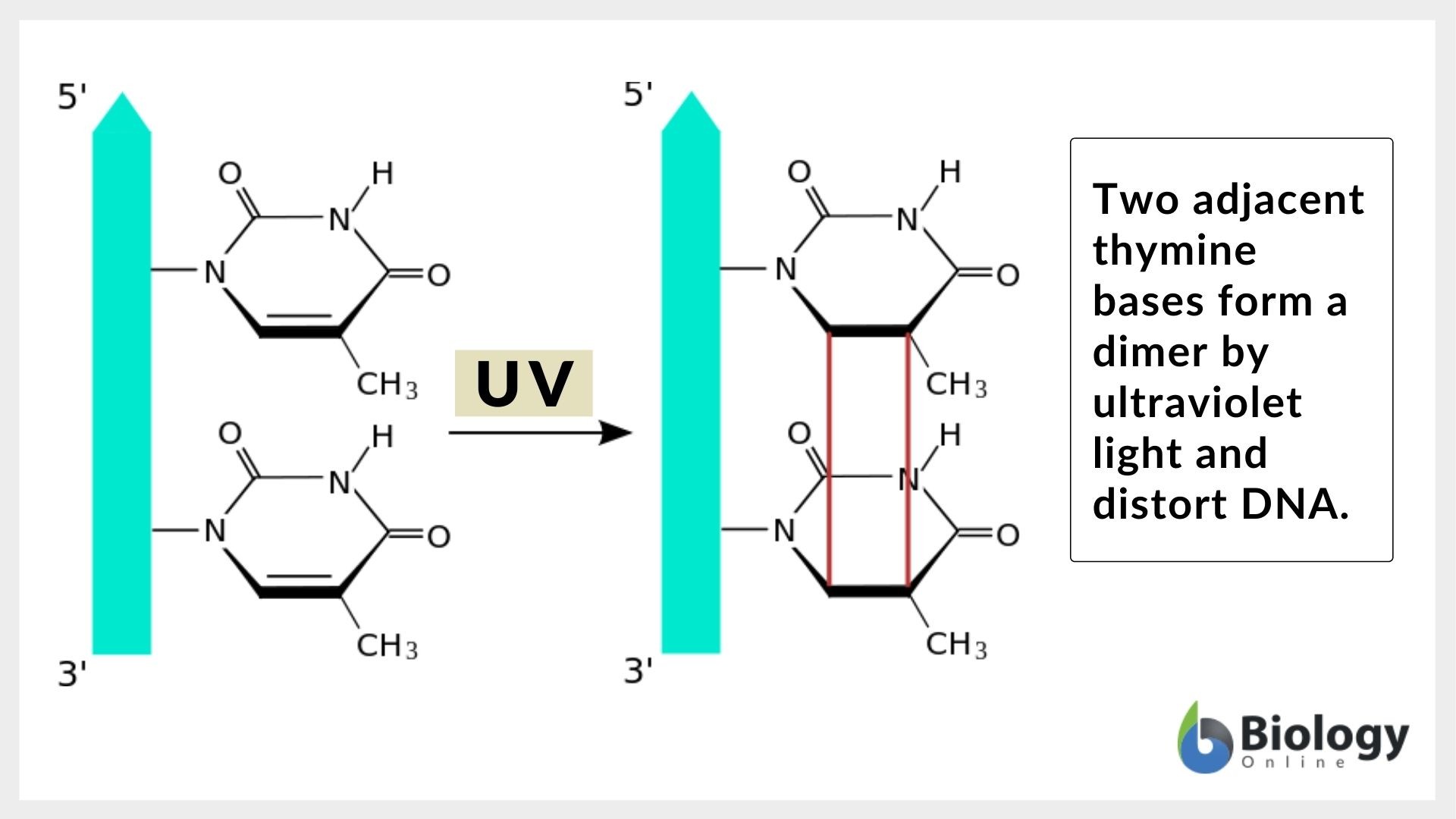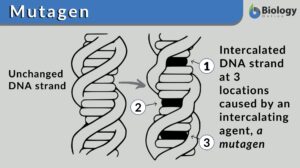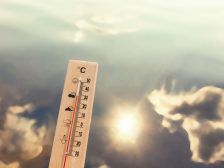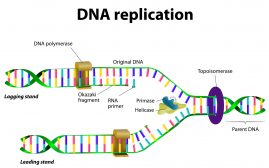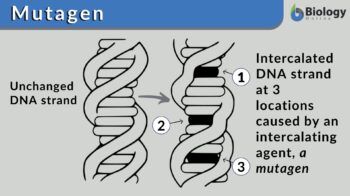
Mutagen
n., plural: mutagens
[ˈmjuːtədʒn̩]
Definition: any agent or substance inducing or causing genetic mutation
Table of Contents
Mutagen Definition
What is a mutagen? A mutagen is a substance or agent that causes DNA impairment that results in the alteration of the DNA sequence. This alteration of the DNA sequence is known as mutation.
Any agent causing mutation is called mutagen. Mutagens can be physical mutagens, chemical mutagens, or biological mutagens. The ability of a substance to induce the alterations in the base pairs of DNA or mutation is known as mutagenicity.
DNA is the hereditary material of the living cell. DNA is a polynucleotide made up of a number of nucleotide units. These units, in turn, are made up of nitrogen-containing nucleobases (cytosine [C], guanine [G], adenine [A], or thymine [T]) that are covalently bonded with sugar (particularly, deoxyribose), and a phosphate group. The typical pattern of nucleic acid bases encodes all the genetic information of a cell. A mutagen alters the specific pattern and sequence of the nucleic acid bases in the DNA resulting in the change in the protein transcribed from it. Though these changes may be inheritable or non-inheritable depending on their occurrence in somatic cells or germline cells.
Some of the common examples of mutagens are- UV light, X-rays, reactive oxygen species, alkylating agents, base analogs, transposons, etc.
Types of Mutations
Depending on the cells that are affected by the mutagen, mutations can be classified as follows:
Somatic mutations
These are mutations that occur in the non-reproductive cells (somatic cells) of the living being. Numerous types of somatic mutations may not be manifested to affect an individual due to the reparative and compensative processes of the body. However, a somatic mutation that alters the cell division patterns of the cell can eventually result in the formation of cancerous cells or tissue.
Germ-line mutations
These mutations occur in gametes or in the reproductive cells that produce gametes or sex cells. These mutations are inheritable and are transferred to the next progeny in all their cells (both somatic and germ-line). Different chemicals have been classified depending on their mutagenicity in germline cells, mentioned in the table.
Table 1: Classification of chemicals based on their mutagenicity in germ-line mutations | |
|---|---|
| Chemical | Properties |
| 1A | Chemicals that are known or established to cause germ-line heritable mutations based on epidemiological evidence |
| 1B | Chemicals that are regarded to cause germ-line heritable mutations based on mutagenicity tests that have been carried out on the in vivo mammalian germ cells or somatic cells |
| 2 | Chemicals that are regarded to cause germ-line heritable mutations based on in-vitro tests or as evidenced from in vivo somatic cell mutagenicity or somatic cell genotoxicity tests in mammals. |
Mutagens are known to increase the incidences of mutations above the spontaneous level. However, here it is important to understand that all impairment or damage in DNA cannot be labeled as mutations. In the majority of the cases, the damaged or altered part of DNA is removed by DNA polymerases during the cell repairing process. However, the mutations caused by mutagens tend to escape this process of cell repairing and thus acquiring a status of ‘permanent’ change in the DNA.
Three types of DNA mutations are known to occur:
- Base substitutions. Single-base substitution is known as ‘point mutation’. These are the most common types of mutations that can result in silent, missense, or nonsense.
- Silent mutations: Substitution of a base that occurs on the third position of the codon. Thus there is a positive possibility that an identical codon will be generated that will code for the same amino acid sequence. Thus, no change in the gene sequence resulting in a silent mutation.
- Missense: A base substitution that leads to the generation of a gene sequence that codes for different amino acids and eventually a different polypeptide sequence.
- Nonsense: A base substitution that results in the generation of a gene sequence that truncates the translation or alteration that leads to the generation of a stop codon that eventually forms a non-functional protein is known as Nonsense mutation.
- Deletion. As the name suggests, deletion of one or more base pairs on the DNA. This can result in a frameshift when one or more base pairs are deleted/removed from the DNA.
- Insertions. The addition of additional base pairs in the DNA may also be frameshifts. However, this frameshift will depend on whether or not the addition of base pairs have occurred in the multiples of three base pairs.
Read: Genetic Mutations – free tutorial on mutations at the gene level and the harm that these mutations may bring.
Understanding Mutagen Biology: molecular mechanisms of mutagenesis
So, how do these mutagens cause mutations? Let’s understand the molecular mechanism of action. Mutagens act on the DNA in a variety of way, some of the common mechanism of exercising mutagenesis include:
DNA damage
The specific sequence of purine bases (guanine and adenine) and pyrimidine bases (cytosine and thymine) attached by a hydrogen bonding, i.e., guanine (G)/cytosine (C) and encode all the genetic information of a living being. A mutagen that alters these base sequences can result in DNA damage.
Spontaneous damage
Spontaneous base deamination, hydrolysis of purines or pyrimidines, and deoxyribose bond results in the formation of apurinic/apyrimidinic (AP) sites. This eventually results in exposing the sugar-phosphate backbone to DNA strand breakage. Additionally, tautomeric forms of the bases exist which can result in several base mispairing.
Chemical adducts
Certain chemical mutagens are electron-deficient species, i.e., highly reactive electrophiles. These reactive mutagens can form covalently bonded nucleophilic adducts within DNA which can stabilize the alternative tautomeric structures of the purine/pyrimidine bases. This will eventually alter the base pair coding. This will result in the transcription of incorrect base pair information and increased susceptibility to hydrolysis of the DNA along with the increased formation of AP sites. Additionally, certain mutagens may also promote inter- and intrastrand cross-linking of DNA, which averts the separation of DNA strands. Thus, resulting in complications during DNA replication, transcription, and repair processes.
Oxidative damage
Mutagens can induce oxidative stress which results in the generation of free radicals (oxygen or nitrogen). These free radicals are highly reactive compounds with unpaired electrons and can be hydroperoxide, hydroxyl, and superoxide moieties. These free radicals interact with DNA and result in breakage of DNA strands, hydrolysis of the bases, or develop lesions on the DNA strand.
DNA intercalation
Some of the mutagens intercalate themselves between the two complementary strands of DNA. This results in the disruption of the hydrogen bonding amongst the base pairs. Eventually, such intercalation results in misread or incorrect replication and transcription processes.
Metabolic activation
The normal metabolic process which occurs majorly in the liver consists of two stages, i.e, stage I and stage II. These metabolic processes aim to eliminate undesirable substances from the body by increasing their solubility. Stage I is carried out by the cytochrome P450 enzyme system wherein the hydroxylation process takes place. While in Stage II, the conjugation process to add polar groups is carried out via glutathione S-transferase, glucuronide transferase, microsomal epoxide hydrase, or acetyltransferase. During this stage II, the majority of the mutagens are generally inactivated, however certain enzymes like flavin monooxygenase and prostaglandin H synthetase have been found to activate the mutagens.
Types and Examples of Mutagens
Broadly, there are three major categories of mutagens. See Figure below.
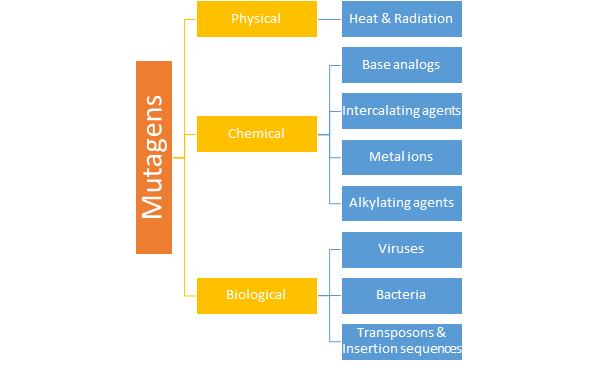
Physical agents
- Radiation. Radiations were the first agents reported to be mutagenic. Ionizing and non-ionizing radiations, like UV rays, X-rays, alpha rays, and neutrons, have been found to exert mutagenic effects. Most of these radiations exert a lethal (i.e., killing the cell) or sub-lethal (i.e., changing the functioning of the cell) effect by directly damaging the DNA or the nucleotides by:
- inducing-cross-linking of DNA or protein
- breaking of chromosomes
- breaking of strands or chromosomal loss
- molecularly deletion of bases/DNA strand breakages
The ionizing radiations or the high energy radiations, such as X-rays and γ-rays, majorly act on dividing cells and affect not only the DNA. Lipids and proteins are also altered by their effect. These rays generate free radical molecules that cause the DNA or chromosome breakage.
X-ray at the dose of 350-500 rems is considered lethal as at this dose they induce breakage of phosphodiester bonds resulting in breakage of DNA strands. UV radiations are non-ionizing radiations as they have less energy as compared to X-rays. These are commonly employed for sterilization and decontamination procedures.
Base deletion, strand breakage, cross-linking, and formation of nucleotide dimers are some of the mechanisms by which UV radiations exert their mutagenic effect.
UV radiations are of three types, UV A, UV B, and UV C. UV-A is the UV rays with a wavelength of 320nm (near-visible range) and is known to result in dimerization of pyrimidines. This kind of pyrimidine dimerization results in alteration of the DNA structure which averts the formation of the replication fork during the process of replication. Such dimerization may lead to health issues. UV-B has a wavelength of 290-320nm and highly lethal to DNA. UV-C radiations have a wavelength of 180-290nm and are the most lethal as well as carcinogenic. UV-C radiations are majorly absorbed by the ozone layer.

Figure 2: Effect of UV light resulting in the formation of thymine dimers. Source: Maria Victoria Gonzaga of BiologyOnline.com, from the works of 鷹ノ巣, CC 3.0. - Heat. DNA is sensitive to temperatures above 95◦C. Above 95◦C, the phosphodiester bonds break in DNA resulting in breakage of DNA strand. Thus, heat results in DNA breakage.
Chemical agents
- Base analogs. These agents possess structural similarities to the bases i.e., purines and pyrimidines. The most common base analogs which are considered as a chemical mutagen are – 5-Bromouracil and aminopurine. Due to structural similarities these agents with the DNA bases, base analogs get incorporated in the DNA structure during the process of replication. Aminopurine is similar to adenine and can form a base pair with C or T (though base pairing with C is rare).

Figure 3: Structure of 5-bromouracil and 2-aminopurine. Credit: Web Books. 5-Bromouracil exhibits tautomeric forms. Each of the tautomeric combines with different base pairs. Keto form of the 5-bromouracil replaces thymine in the DNA and forms a pair with the adenine in the DNA whereas enol tautomeric forms a complementary base pair with guanine. 5-Bromo uracil thereby results in a point mutation. Thus, depending on the tautomeric form, upon replication, such DNA containing 5-Bromouracil changes base pair from A-T to G-C or from a G-C to an A-T.

Figure 4: Mechanism of 5-bromouracil and effect of tautomerism in 5-Bromo-uracil. Credit: Web Books. - Intercalating agents. Intercalating agents are the molecules that have a hydrophobic heterocyclic ring structure and resemble the ring structure of base pairs. These agents place themselves in the DNA helix, which eventually interferes with the replication, translation, and transcription resulting in mutation, most commonly frameshift mutation. Ethidium bromide, proflavine, acridine orange, actinomycin D, or daunorubicin, etc are some of the common intercalating agents. Amongst these, Daunorubicin along with Epirubicin, Epirubicin, and Mitoxantrone are some of the common anti-cancer or antineoplastic drugs.
- Metal ions. Mineral ions like nickel, chromium, cobalt, cadmium, arsenic, chromium and iron, generate reactive oxygen species (ROS) that cause DNA hypermethylation, thereby promoting DNA damage and hindering the DNA repair process.
- Alkylating agents. These agents induce alkyl groups in DNA resulting in DNA damage. The introduction of the alkyl groups increases ionization that results in base-pairing errors and eventually inducing gaps in the DNA strand. Some of the common alkylating agents are ethylnitrosourea, mustard gas, vinyl chloride, Methylhydrazine, Busulfan, Carmustine, lomustine, Dimethyl sulfate, Temozolomide, Dacarbazine, Ethyl ethane sulfate, and Thio-TEPA. Though during the DNA repairing process, these agents can be removed from the DNA by the process of depurination. Depurination is a non-mutagenic process.
Biological agents
- Transposons and Insertion sequences (IS). They are units of DNA that undertake self-directed relocation/multiplication of the DNA fragment. The simplest type of transposons (~10-50 base pair long) are known as insertion sequences or IS. Both IS and transposon are also known as jumping genes as they move from throughout the DNA. The addition of transposons into chromosomal DNA interrupts the functionality of the genes. Both IS and transposons encode the information for the enzyme transposases that helps to create the new transposition location in the DNA. Three types of transposons are usually found:
- Replicative transposons: The transposons that retain the original locus and translocate its copy.
- Conservative transposons: In these transposons, the original transposon translocates itself.
- Retrotransposons transpose: These transposons translocate via RNA intermediates
- Viruses. Disruption of genetic function might be the result of the insertion of viral DNA into the genome. Certain viruses, e.g. Rous sarcoma virus, have been reported to induce cancer. Thus, it can be said, that viruses can be mutagenic.
- Bacteria. Certain inflammation-inducing bacteria like Helicobacter pylori produces reactive oxygen species that results in DNA damage and reduced DNA repair. This raises the likelihood of the mutation.
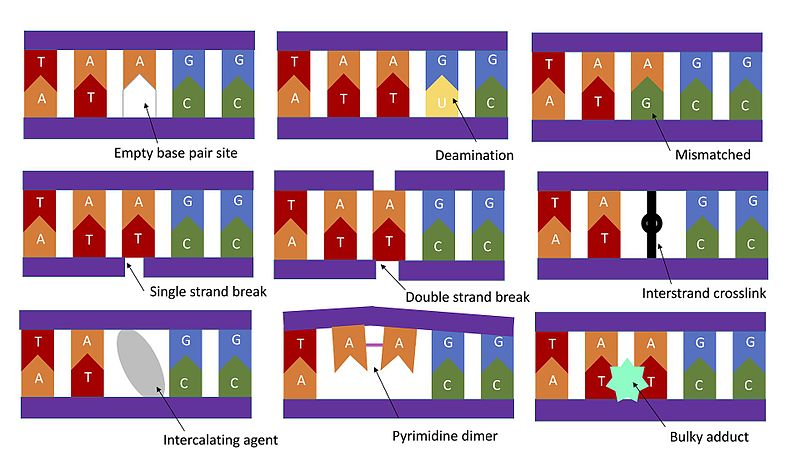
Mutagen vs Carcinogen
At this stage, it is important to understand the difference between mutagens and carcinogens. These two terms are closely related and are often considered synonymous. However, these are two different terms.
Mutagens are the agents that induce alterations in the DNA that can be heritable or non-inheritable. Carcinogens are a substance that induces uncontrollable cell division that results in the development of tumor which may or may not be cancerous. Though these terms are correlated as often the mutagenic agents may induce alterations in the genetic material of the cell that may lead to carcinogenesis. Thus, carcinogenesis may be a resultant effect of mutagenic changes induced by mutagens. Also, mutagens are known to increase the frequency of carcinogenic events.
It is also important to understand that all the mutations may not be life-threatening while carcinogenesis results in life-threatening outcomes.
Another closely related and often synonymously used term is the ‘teratogens‘. Teratogens are the agents that can induce abnormality or defects in the fetus or birth defects while showing no effect on the mother. Ethanol, mercury compounds, phenol, lead compounds, carbon disulfide, xylene, and toluene are some of the teratogenic compounds. Thalidomide is the most well-described teratogenic drug that was initially prescribed for morning sickness in pregnant women in the early 1950s. Thalidomide induced widespread birth defects like missing legs, arms, ears, etc. These widespread incidences led to the withdrawal of the drug from its usage.

Later, in the early 2000s, thalidomide was reintroduced for the treatment of myeloma and leprosy. The other well-known teratogenic drugs are Phenobarbital, Valproic acid, Tretinoin, Tetracyclines, fluoroquinolones, warfarin, Propylthiouracil (PTU), methimazole (MMI), carbimazole, large doses of Vitamin A, Diethylstilbestrol, etc. Diethylstilbestrol is known to be carcinogenic as well as teratogenic.
Effect of Mutagens
Mutations are the alterations in the genetic material of a cell. These mutations can be lethal or non-lethal and also, these can be inheritable as well as non-inheritable. Whatever the case may be, mutations alter the genetic composition.
Many mutations can actually lead to various diseases. Certain mutational diseases are inheritable and occur due to mutation in the germ cell. One such disease is sickle cell anemia, which occurs due to a single missense mutation at codon 6 of the β-globin gene in germ cells. This mutation results in the replacement of the glutamic acid at position 6 in the normal protein by valine. This modification severely affects the oxygen-carrying protein, i.e., hemoglobin. The mutated hemoglobin has a highly reduced oxygen-carrying property and erythrocytes become rigid resulting in the painful passage of the blood cells and even blockade in the capillaries and tissue damage. Interestingly, the defective erythrocytes are resistant to malaria and thus this mutation has been maintained in the African population. Some of the diseases which are the outcome of mutation are retinoblastoma or retinal tumors in children, Tay-Sachs disease, phenylketonuria, color-blindness, and cystic fibrosis.
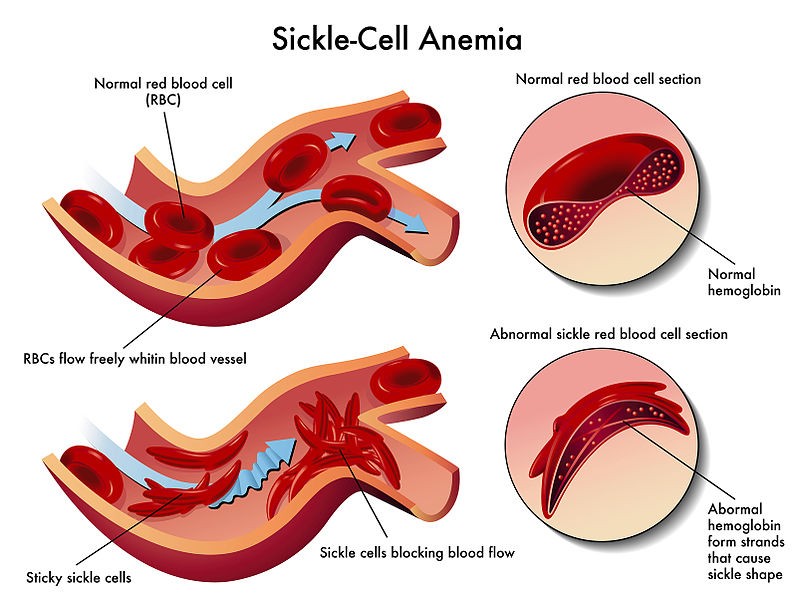
However, it is also important to understand that mutations are not necessarily lethal or harmful. The majority of the mutations that occur are not at all harmful. As a matter of fact, mutations are responsible for the variations in the gene pool that have eventually led to the evolution of life over the years on the earth. Populations with diverse mutations have been able to survive the natural selection process and have evolved as per the requirement. The populations that have been not able to evolve or undergo changes as per the changes in their environment have eventually perished. In fact, the mutation is the first step towards evolution. Developing coat color by insects and animals for camouflage is one such evolutionary genetic step. One interesting beneficial mutation is found in a small Italian community that has mutated protein Apolipoprotein known as Apolipoprotein A1-Milano (or Apo A1M). Normal Apolipoprotein is the protein responsible for the transportation of cholesterol. The mutated version of Apolipoprotein i.e., Apo A1M not only removes cholesterol but also dissolves plaques and also has antioxidant properties. Thus, the Italian community that has this mutated Apo A1M is protected from cardiac diseases.
Try to answer the quiz below to check what you have learned so far about mutagens.
References
- Terzaghi, B. E., Streisinger, G., & Stahl, F. W. (1962). The mechanism of 5-bromouracil mutagenesis in the bacteriophage T alpha. Proceedings of the National Academy of Sciences of the United States of America, 48(9), 1519–1524. https://doi.org/10.1073/pnas.48.9.1519
- Braña, M. F., Cacho, M., Gradillas, A., de Pascual-Teresa, B., & Ramos, A. (2001). Intercalators as anticancer drugs. Current pharmaceutical design, 7(17), 1745–1780. https://doi.org/10.2174/1381612013397113
- Watford S, Warrington SJ. (2020). Bacterial DNA Mutations In: StatPearls [Internet]. Treasure Island (FL): StatPearls Publishing. Available from: https://www.ncbi.nlm.nih.gov/books/NBK459274/
- Tennant, R. W. (2019). Mutagens and carcinogens. AccessScience. Retrieved January 10, 2021, from https://doi.org/10.1036/1097-8542.441100
- National Research Council (US) Committee on Diet, Nutrition, and Cancer. Diet, Nutrition, and Cancer. Washington (DC): National Academies Press (US); 1982. 13 Mutagens in Food. Available from: https://www.ncbi.nlm.nih.gov/books/NBK216630/
©BiologyOnline.com. Content provided and moderated by BiologyOnline Editors.
